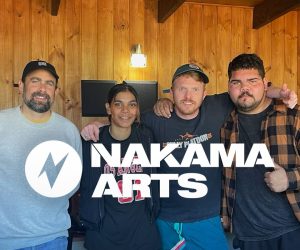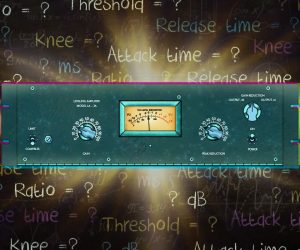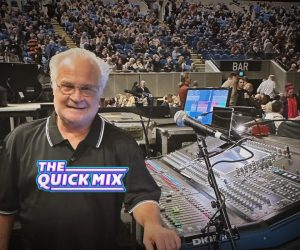
Dog Days: Recording Snarky Puppy
19 musicians, 128 inputs, a live audience on headphones, no overdubs or re-takes… let’s go behind the scenes of Snarky Puppy’s latest album Empire Central.
Recording a Snarky Puppy album is a high-wire act. 19 world-class musicians packed like sardines into the same room playing complex jazz compositions around a seated audience who savour the live experience on headphones. There isn’t a sheet of music in sight. Band members will often bounce from one instrument to another during a song, others will manipulate effects and filters on the fly. All 128 inputs are recorded live as the band plays — no overdubs, no multi-tracking.
Printing a solid take with five musicians is hard enough – much less with 19, and with so many moving parts. Pick the best takes of each song across eight nights of live performances and, boom: you have a Snarky Puppy album.
DIFFERENT LEAGUE
The brainchild of bassist Michael League, Snarky Puppy has become known for producing these types of albums. And the only thing as satisfying as listening to the music itself is watching the spectacle unfold on YouTube – videos are an indispensable part of the Snarky Puppy experience, and it’s no surprise given the thrilling ‘in-the-moment’ vibe of their unconventional album recording method.
After hearing (and watching) Trinity, the first song on Snarky Puppy’s new album Empire Central, I was reminded why the band has experienced snowballing popularity. Naturally the musicianship, arrangements and creativity are second to none. Yet there’s more than just skill on display, each musician wields their instrument in a manner that pushes its sonic envelope into fresh and exciting territory. The first few moments of Trinity features a saxophone that sounds like it’s running through a wah pedal. A Moog synth lead processed through an MXR talkbox is a central feature throughout. Wild delays and smooth pads cascade across the soundstage. The array of sonic textures featured in a six-minute song is pure ear candy.

MAKE TRACKS
The Empire Central sessions were held over eight days at Deep Ellum Art Company in Dallas, Texas. Bar tables and chairs made way for the full backline of all 19 musicians, two Avid S6L consoles (one for monitors, one for the audience mix), a slathering of carpet as makeshift acoustic treatment, and miles of cables.
I had the opportunity to speak with the audio engineers of Empire Central. Needless to say, they had their work cut out for them. The album recording concept is a high stakes form of audio engineering with plenty that could go wrong and little room to ‘fix it in the mix’.
Nic Hard recorded and mixed the album with the assistance of Michael Harrison, Matt Recchia and Skyler Childress. Nic wore the foreman hat at the recordings – his role was to design the recording system, pick the mics, and have a sonic vision for the end product.
“For me, the goal was to have it sound as good as a studio album, and for it to be as creatively expressive as a studio album, but still maintain the live energy. So beyond that general, vague description, that was really all I wanted to get out of it. Any finer things were really up to the situation.”
To begin with, we talked about the freakish logistical challenge of tracking 128 inputs while simultaneously mixing a ‘front of house’ mix for the audience’s headphones feed.
Mike Harrison nutshells the feeling: “It’s chaos to begin with, and to end with, and at every point in between.”
“The sheer number of people already makes it very different than most sessions,” observes Nic Hard. “Having three drummers is already more channels and inputs than most normal recordings. Just by volume it’s more complicated. Trying to make sure 19 people are happy is also tricky.”
“And it’s the same on output world as well,” says Mike, whose job it was to mix what the audience hears on their headphones. “It’s equally complex if not more.”
the goal was to have it sound as good as a studio album, and for it to be as creatively expressive as a studio album, but still maintain the live energy


IN THE CANS
As Snarky Puppy’s FOH engineer on live tours, Mike is accustomed to working with big PA systems with plenty of clarity, space and headroom to give every instrument its place. Delivering the same clarity and ‘live show’ experience on a set of budget Audio-Technica headphones is quite a different task.
MH: “You have an immediate difficulty there. Normally I’m mixing on $50k to $500k worth of speakers. Here you have a $50 set of retail cans and you’re trying to put a lot of information into some very small sonic boxes. That was the biggest compromise; trying to keep the dynamic of the band performing live and not having it crushed. You actually get a very narrow letterbox and the frequency response needs to be curtailed. It was kind of like broadcast mixing but you’re still in the midst of the band.”
Mike didn’t shy away from treating the audience mix with effects, especially reverb. “When I mix live I’m a big advocate of lots of reverb; well-chosen, but I use a lot of reverb. There are certain places in the albums that sound quite saturated and spacious and that was one of the way we got around dry sounds and bleed. You can do a lot to make an instrument sound suddenly very large without taking up much space in the mix by using an explosive reverb. There’s one Nic suggested I dial in on the song Belmont where you’ve got a second snare that’s very deep and heavy and normally dry sounding. In this case we broke with the normally dry sound and basically threw it down a well with four or five seconds of heavy reverb to make it a very slow ballad sound. That was a nice departure from the norm with just one effect. And I use reverb on brass and percussion instruments – it makes them sound alive.”

It’s chaos to begin with, and to end with, and at every point in between
SPILLAGE
Naturally, with 19 musos in the room, keeping spill under control was a serious consideration. Doing away with amps helped a great deal. The three guitarists replaced their cabs with Kemper Profilers and all keyboards and synths were DI’d. That left horns, percussion and the three drum kits as the primary noise makers in the space.
Nic’s philosophy for mic selection was mostly guided by a studio recording approach with the added criterion of excellent isolation properties to reject bleed. For example, Beyerdynamic M160 hypercardioid ribbon mics were used as drum overheads. Horns were mic’d up using both the Audio-Technica AT4081 ribbon mic alongside the highly directional Lauten Audio LS-208.
NH: “In normal studio situations I really like ribbons on horns. In this situation with the drums and the bleed and everyone in the same room I wasn’t sure if the ribbons were going to cut it. So I wanted to have something else there as well and those Lauten Audio mics have got a lot of rejection. I had the two so I could choose between them in mixing. I actually ended up using both for most of the horns.”
The Lauten/Audio-Technica combination worked so well Mike Harrison used both in his audience mix as well.
MH: “The ribbon mics on the horns worked out better than we both expected. If you think about a horn player addressing a ribbon mic, the nulls are at 90° and 270°, so the drums were off the horn players’ shoulders and the second live side of the ribbon mic was facing keyboard world where there wasn’t a lot of noise coming from that direction. The Lautens were fantastic. We chased down hypercardioid mics and mics with high rejection for live use and I thought the Lautens were brilliant. But I was surprised how much the Audio-Technicas didn’t lose to them – they held up in figure-8 mode.”
Mike ensured the precise positioning remained consistent across the eight performances. “One of the things I did between sessions was go around and make sure the mics were aligned as microscopically as possible so we didn’t have phase issues with one having drifted an inch forward or another where a microphone stand sags or takes a little nudge.”

PURPLE PATCH
Matthew Recchia had the tedious but crucial task of patching the inputs. It’s a role he apprehends with confidence. Matt is no stranger to managing swathes of connections on the live stage as well as on film and TV sets. As Mike puts it, Empire Central saw Matt “bring that stage manager role to a horrendously large recording session. He’s very particular with cabling – it’s not seen, it’s not interfered with, it all goes to a particular place.”
Matt was occupied during the sessions too. While Mike whipped up a studio-quality mix for the audience’s cans, Matt had the equally challenging role of mixing monitors on another Avid S6L for all 19 musicians, most of whom wore Audio-Technica M50s. The Hear Back Pro headphone monitoring system gave the musicians a degree of blending control between submixes Matt created for them. Ambient mics were also piped into the mix to allow the band to feel the energy and vibe in the room.
MH: “We’ve got 128 channels coming in. The band only receives a stripped down number to make it easier to navigate. Matt was preparing group mixes and isolated musician mixes as well so they could blend between, say, the horns as a group, but also wanting more of one keyboard.”

MIXING
Once the eight shows were locked and loaded, the mixing began. Nic mixed the album entirely in Pro Tools on a 2018 Mac Mini with 48GB of RAM.
Despite the multitude of tracks, Empire Central has a distinctive sonic clarity that’s attracted the praise of many Snarky Puppy listeners. Although it’s a live recording, each instrument presents with detail and immediacy as though it’s been tracked under controlled studio conditions.
Nic explains how he creates such clean sounding mixes. “In this case the quality of the sounds really comes down to the musicians. Especially with drum sounds – the number one way to get a good drum sound is to use a good drummer. Then the tuning of the drum, then the room that it’s in, then the microphones and the audio gear.”
Speaking of good drum sounds, it’s worth noting the fine work of Mason Davis, the drum tech who undertook the superhuman task of organising, setting up, precisely tuning and maintaining all of the drums and percussion items throughout the sessions.
Back to Nic’s mixing workflow. “The first thing I do is manually edit out bleed. Mike [League] did a bunch of this editing himself. With 128 channels it’s a long process and it takes half a day to edit this stuff, so while I was mixing a song Mike would be editing the next one. When it came to the percussion it sometimes was a little bit hard to tell which microphone was more useful, which one had more bleed. So the next thing was making a choice of which microphone to use, and with the horns whether I was going to use both mics or one mic – things like that. Then after that it’s usually EQ for the purpose of cleaning — getting rid of low end that’s not needed. Once things have been appropriately cleaned then it’s about EQing for the way they fit together.
“I use the FabFilter ProQ3 on almost everything, just because it’s super versatile and can do so many things I need it to do. Then, if I need something with a bit more colour, I’ll go to a Neve emulation or something like that.”
Since video plays a big part in Snarky Puppy’s online presence, the visuals dictated the audio mix to some degree. “I had a rough cut of the video for these songs so I was basically mixing with the video,” says Nic. “I could see when things were looking weird, which was helpful.
“In this instance I approached it as a studio album. In some cases we were re-amping guitars, adding effects, and not being too precious with it having to be totally represented but also not looking or sounding weird with the video. I’ll do a first pass of a mix then Mike [League] and I will sit together and work on it. The process for this album was pretty straightforward. We didn’t go too crazy with effects.
“As far as blending all of the tracks together, there’s definitely a lot of thought that goes into the EQ and the way that these things interact with each other and trying to keep stuff heard throughout but obviously featuring instruments when they need to be featured. So there’s a lot of automation as well.”


IMMERSIVE
Empire Central is the first Snarky Puppy album to also be available in Dolby Atmos. Nic had the opportunity to mix the songs in the immersive format for the first time at Fab Dupont’s place in New York and he relished the experience. “It’s the first thing I’ve mixed in Atmos. I have to say I went in a little bit skeptical – ‘another surround sound format’ – but it took about an hour before I was super excited about it and how it worked really well with this band. Being able to expand beyond two speakers and be immersed in the band was really exciting and a lot of fun. I now know what it sounds like to have your head inside a Leslie cabinet.”
EARLY REFLECTIONS
I asked the three if, looking back on the recordings, there were any feats they are particularly proud of. Matt’s answer: “That it all worked! We only had a day to put the setup together while the musicians were coming in and wanting to do stuff. So it’s pretty remarkable that we pulled it off.”
That sense of achievement and relief is well deserved, as feedback from Michael League will attest to. Nic says, “During mixing, Mike kept saying this was the smoothest Snarky record ever – studio album or live. It was the least painful.” Certainly a result to be proud of.
Empire Central can be streamed online through most platforms.























RESPONSES